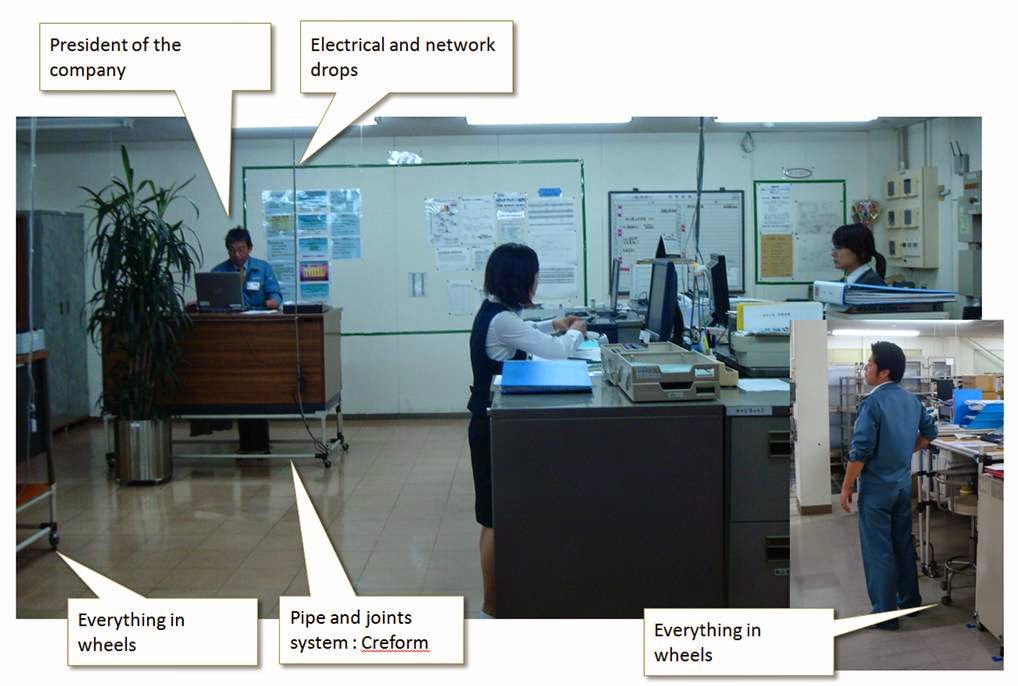 |
| "Where do you want me to go now?" |
Although there are well proven solutions for organizing manufacturing workplace such as implementing U-shaped cells to tear down large batch production lines, little has been shared about designing office space using Lean principles. This post is an initial effort to address this void by discussing some important findings and sharing examples from companies such as Kaas Tailored in the US and HOKS in Japan that I had the opportunity to visit thanks to the Kaizen Institute.
How office workplace affects teams performance
In the 70's, MIT professor Thomas Allen led a series of experiments to understand what factors make some teams more innovative and effective than others. He discovered that the most relevant factor shared by innovative and highly effective teams is their physical proximity. In other words, teams that have their members very close are much more effective than similar teams that have their team members farther away.
The explanation behind this finding is based on how team members exchange critical information. Professor Allen found out that interpersonal communication rather than technical reports, publications, email or any other written documentation is the common means how teams collect and transfer relevant information. In practical terms, any documentation is most useful when knowledgeable people is directly available to explain and supplement its written instructions or content.In this way, office spaces where people are separated by walls, cubes or other physical structures have lesser interpersonal communication and thus lower overall performance. On the other hand, workplaces in which people can quickly and effectively communicate allow teams to be more effective.
Professor Allen's conclusion supports the importance of information flow in an office environment. However, based on this finding, how should be set a lean office workplace be organized? Before answering this question let's review two relevant studies about workplace and team effectiveness.
Developing smarter teams
In 2010, two academics from MIT identified that the smartest teams, better decision makers teams, were distinguished by three characteristics: (1) their members contributed more equally to the team's discussions, rather than letting one or two people dominate the group, (2) their members can better read emotional states, and (3) more women team members. This last characteristic, as explained by the study, it is not about diversity but related to the fact that women are better at reading emotions. What these findings have to do with a office workplace? A lot. Any office space that allows members to contribute equally and to better read their emotional state would definitive develop smarter teams.
On-site versus online work
How online collaborative tools (Skype, email, etc.) would affect the way we organize office workplace? A new study from MIT Center for Collective Intelligence identified that emotion-reading matters just as much for teams online teams or off-line. They findings indicated that it is not physical proximity but emotional perception what make the difference. However, reading emotions is much harder using a phone, email or Skype than in a face to face conversation.
Examples for creating lean office workplace:
I. Kaas Tailored USA
Kaas Tailored is a company with many years practicing kaizen (continuous improvement.) Their office space has several interesting solutions from which we can learn a lot.
- Avoiding stopping communication flow. Contrary to traditional office space, their office layout does not have cubes or walls. The desks are organized forming a circle allowing information to flow quiet efficiently by rolling their chairs or just walking.
- Health and flow. Desks are high enough so people can work standing-up; however, they have high chairs if they wish to sit. There is a lot of evidence that sitting for long periods of time is bad for our health so stand-up desks with high chairs appear a great solution from health and flow perspective.
- Continuous Improvement. The office space is designed for experimentation. Power, network and phone cables are "dropped" so changes in the layout are easy to implement by the associates with limited need of facilities or contractors. Note that all desks are wheeled.
- Visual. The space is immersed in visual clues. By just standing, you can have a good idea of the information flow.

These workstations are built using a flexible system based on tubes and joints that can be put together by anyone with non or little experience and few simple tools. In this way, people can take ownership on improving by their own, allowing faster cycles of experimentation and improvement. Some well known providers in the US and Europe are:
- Creform, www.creform.com
- Fastube, www.fastube.com
- NIS, www.nisusa.com
- Flowstore, www.flowstore.co.uk
- Fastube, www.fastube.com
- NIS, www.nisusa.com
- Flowstore, www.flowstore.co.uk
Although most of these systems were original created for manufacturing, they are evolved and used in hospitals, retailers and offices in general as you see with Kaas Tailored above.
II. HOKS (Japan)



With a Six Sigma certification, you will be able to position yourself as a change agent within the organization, spearheading quality improvement throughout a team.
ReplyDeleteSix sigma certification in India | Green Belt Training in India
Lean is a production practice that considers the expenditure of resources for any goal other than the creation of value for the end customer to be wasteful, and thus a target for elimination.
ReplyDeleteLean Six Sigma Certification in India | Six Sigma Certification in India
Very nice and informative blog! Thanks for sharing..Six Sigma Black Belt Certification
ReplyDelete